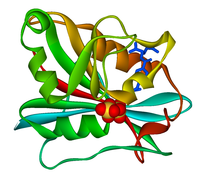
Photo from wikipedia
The ability to sample multiple reactions on the same single enzyme is important to link rare intermediates with catalysis and to unravel the role of conformational changes. Despite decades of… Click to show full abstract
The ability to sample multiple reactions on the same single enzyme is important to link rare intermediates with catalysis and to unravel the role of conformational changes. Despite decades of efforts, however, the single-molecule characterization of nonfluorogenic enzymes during multiple catalytic turnovers has been elusive. Here, we show that nanopore currents allow sampling the dynamic exchange between five structural intermediates during E. coli dihydrofolate reductase (DHFR) catalysis. We found that an endosteric effect promotes the binding of the substrate to the enzyme with a specific hierarchy. The chemical step then switched the enzyme from the closed to the occluded conformation, which in turn promotes the release of the reduced cofactor NADP+. Unexpectedly, only a few reactive complexes lead to catalysis. Furthermore, second-long catalytic pauses were observed, possibly reflecting an off-path conformation generated during the reaction. Finally, the free energy from multiple cofactor binding events were required to release the product and switch DHFR back to the reactive conformer. This catalytic fueled concerted mechanism is likely to have evolved to improve the catalytic efficiency of DHFR under the high concentrations of NADP+ in E. coli and might be a general feature for complex enzymatic reactions where the binding and release of the products must be tightly controlled.
Journal Title: ACS Catalysis
Year Published: 2022
Link to full text (if available)
Share on Social Media: Sign Up to like & get
recommendations!